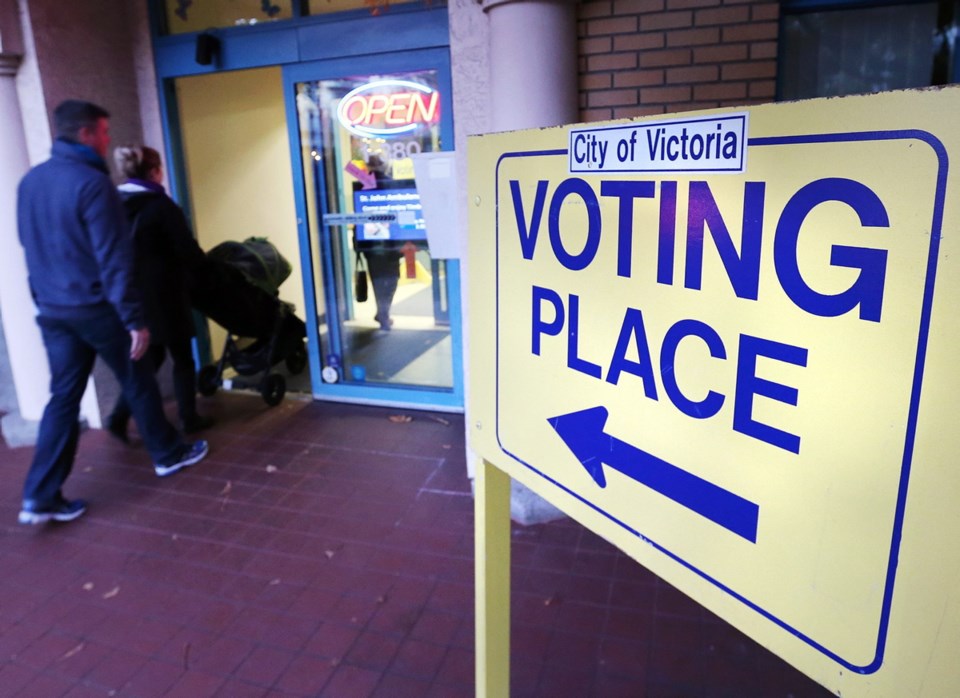 Call it a glorious triumph of direct democracy over the parochial politicians who really didn’t want the people to have a voice.
Call it a glorious triumph of direct democracy over the parochial politicians who really didn’t want the people to have a voice.
Or call it a needlessly complicated mess for Coralee Oakes to clean up.
Now that a majority of Greater Victorians have voted in favour of some flavour of amalgamation question, it’s up to cabinet minister Oakes to decide what happens next.
Amalgamation Yes, the grassroots organization that forced the issue onto the great majority of capital region ballots, has no doubt about what she should do.
“It’s obvious that there’s a clear voice,” said spokesman John Vickers on Saturday night. He wants Oakes and the region’s mayors to get behind a study that would lead to a vote on new civic borders in 2018, when the next local elections will be held.
Amalgamation Yes figured that if it could only break the dam of opposition thrown up by local councils (which generally embraced the amalgamation idea with all the enthusiasm of a man going for a colonoscopy) and actually get a question on the ballot, a flood of support would follow. That’s what happened — sort of.
The common-sense approach would have been for all 13 capital region councils to put the same, simple question to voters: Do you want to look at amalgamation? A majority ‘yes’ vote would trigger a provincially funded independent study of the pros and cons of merging municipalities, with another vote on actual amalgamation flowing from that.
But, this being Dysfunction-By-The-Water, where every player in the band insists on playing a different song, our 91 mayors and councillors couldn’t bear to co-operate. We were left with eight municipalities each asking its own questions, and the other five asking nothing at all.
• Only Victoria took the simple route, asking voters: “Are you in favour of reducing the number of municipalities in Greater Victoria through amalgamation?” No surprise that Victorians voted 80 per cent in favour, 18,351-4,601.
• Esquimalt asked the same question (which passed 2,905-1,404), but added a second: “Should Esquimalt explore options for sharing more services with other municipalities?” which also passed, 3,751-538.
• Saanich’s question reflected local politicians’ reluctance to let go of the reins: “Do you support council initiating a community based review of the governance structure and policies within Saanich and our partnerships within the region?” The result was an overwhelming 88 per cent yes vote (21,437-2,780).
• Oak Bay’s wording — “Are you in favour of the District of Oak Bay being amalgamated into a larger regional municipality?” — was seen by amalgamation proponents as an ill-disguised attempt at sabotaging the result. Instead of asking “do you favour an amalgamation study,” they went straight to “do you favour our municipality getting swallowed up.” Oak Bay was the only municipality to vote no, 3,594-2,184.
• Yet in Langford, where the question matched Oak Bay’s, the yes side eked out a 2,222-2,209 win.
• Central Saanich, Sidney and North Saanich all asked if the province should fund a cost-benefit analysis of the amalgamation of those three municipalities alone. All three voted yes: 2,881-1,727 in North Saanich, 2,566-1,232 in Sidney and 3,588-1,489 in Central Saanich.
Those last results mesh nicely with the model most commonly proposed over the years: one municipality on the Peninsula, another encompassing the core and a third covering the West Shore, with Sooke and perhaps Metchosin going it alone. The footprints of the three communities would roughly match those of the three local school districts.
In early October, Oakes issued a statement saying: “For those communities who are interested in continuing to examine governance structures, following the election results I will make ministry staff available to provide necessary resources and support.”
Taken literally, that could mean looking at the peculiar questions of Victoria, Saanich, Esquimalt, Langford and the Peninsula in isolation, with no attention at all to Oak Bay (not to mention Colwood, Sooke, Metchosin, View Royal or Highlands, where councils refused to let the voters have a say). But common sense says there’s a broad, region-wide taste for gathering more information on the implications of changing the way we’re governed. With the exception of Oak Bay, voters everywhere answered “yes” to whatever question was posed.
“It’s a clear indication to the province,” Vickers said.
The one thing that is certain is that the provincial government cannot force amalgamation on any municipality that doesn’t want it. B.C.’s community charter explicitly bars the legislature from forcing shotgun marriages.



